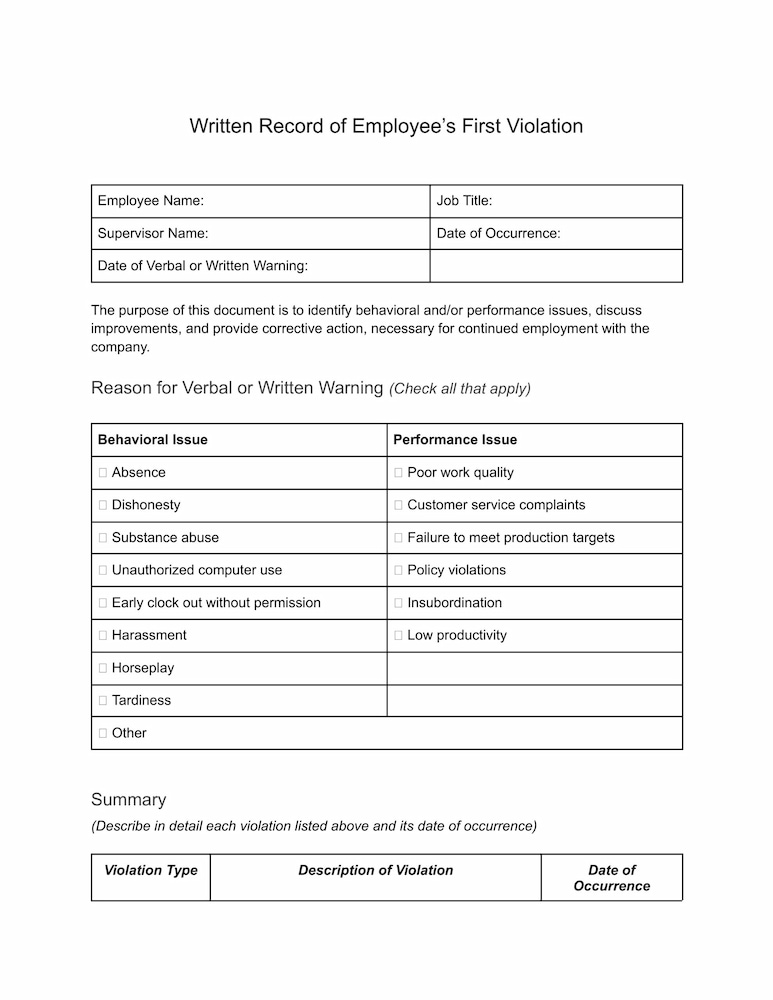An employee write-up form is an essential tool for documenting incidents, performance issues, or policy violations within a company. By providing a standardized way to record these events, write-up forms help managers handle workplace issues fairly and consistently, ensuring that all relevant information is captured accurately. These forms serve multiple purposes: they promote accountability, create a clear record for future reference, and support open communication between employees and management. When used thoughtfully, write-up forms not only help organizations maintain professional standards but also deal with unproductive employees, encouraging them to grow and improve through structured feedback.
In the sections that follow, we’ll explore the components of an effective employee write-up form, common scenarios where these forms can be valuable, and best practices for crafting them to ensure fairness and clarity.
What Is an Employee Write-Up Form & Why Use It?
An employee write-up form is a formal document used by management to record specific instances of employee behavior, performance issues, or policy violations. It functions as an official record, capturing essential details such as the date of the incident, a description of the issue, and any actions that have been or will be taken.
By documenting issues systematically, these forms provide a transparent record that can support future decisions regarding the employee’s role or responsibilities.
Why use an employee write-up form?
Using a structured and official write-up form offers several benefits for both employers and employees:
- Promotes consistency: With a standardized form, managers can ensure that similar situations are handled uniformly, creating a fairer work environment.
- Supports accountability: By formally documenting incidents, employees are more likely to recognize the importance of addressing any performance or behavior issues.
- Assists in legal compliance: Write-up forms create a record that can be crucial if issues escalate to legal or human resources involvement. Proper documentation shows that issues were handled fairly and consistently.
- Facilitates employee improvement: When coupled with constructive feedback, a write-up form can highlight areas for growth, helping employees understand what is expected of them and how they can meet those expectations.
Write-up forms are beneficial across industries, providing essential documentation for consistent handling of employee issues. For instance, in the restaurant industry, a restaurant write-up form is used to address specific concerns like food safety, hygiene standards, and customer service expectations. Tailoring these forms by industry helps ensure each sector addresses relevant challenges clearly and effectively.

Ultimately, an employee write-up form is a proactive tool for maintaining workplace standards, supporting open communication, and helping both managers and employees work toward a more productive and positive workplace.
Key Components of a Write-Up Form
A well-structured employee write-up form captures the essential details of a workplace incident or performance issue, making it clear and actionable. Here are the key components to include:
- Employee information: Basic information such as the employee’s name, job title, department, and employee ID (if applicable) for easy reference.
- Date and time of the incident: Clearly recording the date and time of the incident ensures accuracy and helps establish a timeline for any patterns in behavior.
- Detailed description of the issue: This section should outline the specific behavior or performance issue, focusing on objective facts without personal opinions. Clear, factual descriptions can prevent misunderstandings and make it easier for employees to understand the concern.
- Policy or standard violated: Referencing the specific company policy, rule, or standard that was violated underscores the importance of the issue and links it to company expectations. This connection makes the write-up objective and highlights how the behavior affects the organization.
- Witnesses or other involved parties: If other employees witnessed or were involved in the incident, noting their names here adds context and supports objectivity. It may also be necessary if further clarification is needed.
- Employee response or comments: Allowing space for the employee to add their comments or responses to the issue promotes transparency and allows them to share their perspective.
- Action taken or disciplinary measures: This section details the immediate actions taken and any corrective or disciplinary measures implemented, such as a verbal warning, further training, or a probation period.
- Signatures and date: The signatures of both the employee and the manager indicate that both parties acknowledge the details of the write-up. The date ensures the document is current and formalizes the record.
Including these components in an employee write-up form helps create a clear and consistent record that supports accountability, transparency, and fair management practices across the organization.
Best Practices for Creating and Using Employee Write-Up Forms
Effectively using an employee write-up form requires a balanced, fair, and consistent approach. Here are some best practices:
📝 Be objective and specific: Avoid generalizations or subjective language when describing incidents. Stick to the facts, using specific examples of behavior to ensure clarity and reduce misunderstandings.
💬 Keep communication open: Schedule a conversation with the employee to go over the write-up. This creates an opportunity to discuss the issue directly, hear the employee’s perspective, and clarify expectations.
📅 Document promptly: Write up incidents as soon as possible to ensure accuracy and relevance. Fresh documentation also strengthens credibility if a pattern of behavior needs to be established later.
🔄 Focus on solutions and improvement: Frame the write-up as a tool for improvement rather than a punishment. Outlining clear, actionable steps the employee can take to improve can foster a more productive response.
⚖️ Be consistent: Apply the write-up process consistently across all employees to maintain fairness and avoid claims of bias. Consistency reinforces organizational standards and sets clear expectations for all employees.
📈 Follow up on progress: After documenting and discussing the incident, set up a timeline to review progress. Regular follow-ups demonstrate support for improvement and allow adjustments to any corrective actions as needed.
🔒 Ensure confidentiality: Keep write-ups secure and confidential to respect employees’ privacy and to maintain a professional work environment. Only relevant personnel should have access to these records.
Employee Write-Up Forms
Here are five examples of a template for employee write-ups, each tailored to address different types of workplace situations (including an employee disciplinary write-up form and a no-call no-show case). These forms include key components to clearly document issues and set actionable goals for improvement.
1. Attendance Write-Up Form
Employee Name:
Date:
Position:
Supervisor:
Incident Date(s):
Description of Issue:
Describe specific attendance issues, such as late arrivals, early departures, or unexcused absences.
Policy Referenced:
Reference company policy on attendance and punctuality to provide a basis for the corrective action.
Corrective Action:
Outline steps for the employee to improve attendance, such as setting specific arrival times and emphasizing the importance of notifying supervisors about absences.
Employee’s Response:
Allow the employee space to respond or provide any context.
Follow-Up Date:
Schedule a date to review attendance and ensure improvement.
Supervisor Signature:
Employee Signature:
2. Behavioral Conduct Write-Up Form
Employee Name:
Date:
Position:
Supervisor:
Incident Date(s):
Description of Issue:
Detail specific behavioral incidents, such as disrespectful language, inappropriate comments, or violations of company conduct policies.
Policy Referenced:
Mention relevant policies, such as code of conduct, harassment, or interpersonal communication guidelines.
Corrective Action:
Suggest actions like mandatory training, one-on-one coaching sessions, or revised communication guidelines.
Employee’s Response:
Give the employee an opportunity to share their perspective.
Follow-Up Date:
Set a future check-in to assess improvement.
Supervisor Signature:
Employee Signature:
3. Performance Write-Up Form
Employee Name:
Date:
Position:
Supervisor:
Incident Date(s):
Description of Issue:
Specify areas where performance is below expectations, such as not meeting sales targets, incomplete projects, or low productivity.
Policy/Performance Standards Referenced:
Reference any documented performance standards or metrics the employee is expected to meet.
Corrective Action:
Outline concrete steps for improvement, such as additional training, specific performance targets, or mentorship.
Employee’s Response:
Provide space for the employee to respond.
Follow-Up Date:
Identify a date for a performance review to check for progress.
Supervisor Signature:
Employee Signature:
4. Safety Violation Write-Up Form
Employee Name:
Date:
Position:
Supervisor:
Incident Date(s):
Description of Issue:
Describe the specific safety violation, including details of the incident and any equipment or protocols involved.
Policy Referenced:
Reference the safety policies or regulations that apply, such as OSHA guidelines or internal safety procedures.
Corrective Action:
Specify required actions, such as safety training, procedural reviews, or equipment use instructions.
Employee’s Response:
Allow the employee to provide context or feedback.
Follow-Up Date:
Schedule a follow-up to ensure compliance with safety practices.
Supervisor Signature:
Employee Signature:
5. Customer Service Write-Up Form
Employee Name:
Date:
Position:
Supervisor:
Incident Date(s):
Description of Issue:
Provide details of the customer service issue, such as customer complaints, lack of response, or inadequate service provided.
Policy/Service Standards Referenced:
Mention any customer service policies or quality standards that were not met.
Corrective Action:
Include steps like customer service training, shadowing a peer, or guidelines on managing customer interactions.
Employee’s Response:
Provide space for the employee to explain their side or ask questions.
Follow-Up Date:
Set a date to assess improvements in customer service quality.
Supervisor Signature:
Employee Signature:
Mistakes to Avoid When Creating a Write-Up Form
When utilizing write-up sheets for employees, it’s essential to avoid common pitfalls that can undermine their effectiveness and fairness. Here are key mistakes to watch out for:
🎯 Lack of specificity: Failing to provide detailed descriptions of incidents can lead to misunderstandings. Specific examples help clarify the issues and ensure the employee understands the context.
⚖️ Inconsistency in application: Applying write-up forms inconsistently across employees can create perceptions of favoritism or discrimination. Ensure that the process is standardized and fair for all team members.
📂 Neglecting documentation: Not keeping thorough records of incidents can lead to legal challenges if the employee disputes the write-up. Always document discussions, actions taken, and follow-up steps.
🗣️ Ignoring employee input: Dismissing the employee’s perspective can result in a lack of trust and motivation to improve. Allow space for their response and take it into account during discussions.
📅 Failure to set follow-up plans: Without follow-up dates or action plans, it can be challenging to assess improvement. Establish clear timelines for revisiting the issues addressed in the write-up.
❗ Using emotional language: Writing in an overly emotional or accusatory tone can escalate tensions. Stick to objective language and focus on facts to maintain professionalism.
📚 Not training managers on proper usage: If managers are not adequately trained on how to fill out and use staff write-up forms effectively, inconsistencies and mistakes are likely to occur. Provide training on best practices and legal implications.
Avoiding these mistakes can lead to a more constructive process, promoting accountability and improvement while maintaining a respectful workplace environment.
Transforming Performance Management with Employee Write-Up Forms
Using write-up forms for employees is an effective strategy for managing performance issues and maintaining a professional work environment. By ensuring clarity, consistency, and fairness in documenting incidents, organizations can foster accountability and support employee development. Avoiding common mistakes enhances the process, making it a constructive tool for both management and staff.
To further streamline this process, consider using tools like Everhour. With features for tracking employee performance, time management, and workload allocation, Everhour can help integrate work write-up forms into a broader performance management framework. This ensures that feedback is documented and tied to actionable insights that promote continuous improvement within your organization.
By combining effective write-up forms with robust management tools, businesses can create a culture of transparency and growth, ultimately leading to better employee engagement and satisfaction.
If you are managing a team of 5 or more and looking to boost efficiency, Everhour is the perfect time tracker to keep your team on track. With seamless time tracking, you can easily estimate task durations, set clear budgets, and generate detailed reports inside Asana, Trello, Jira, or any other pm tool.

